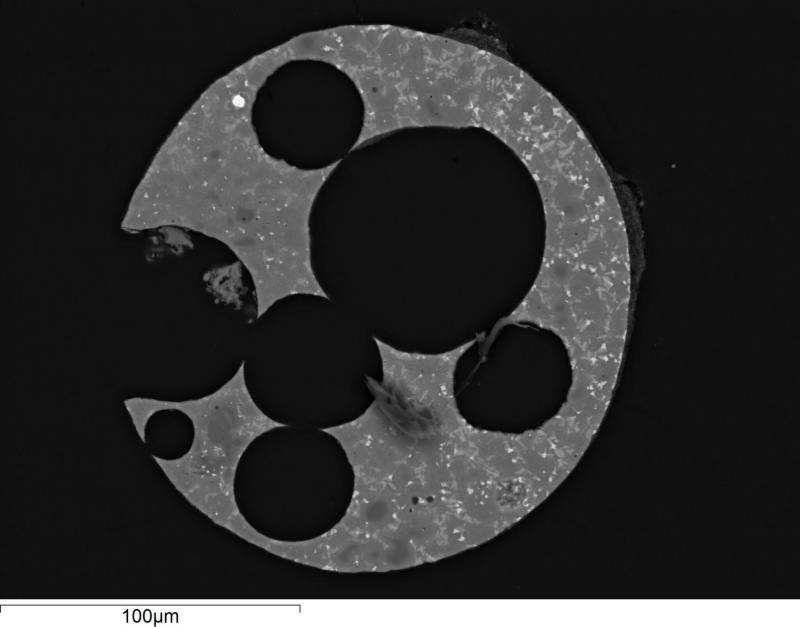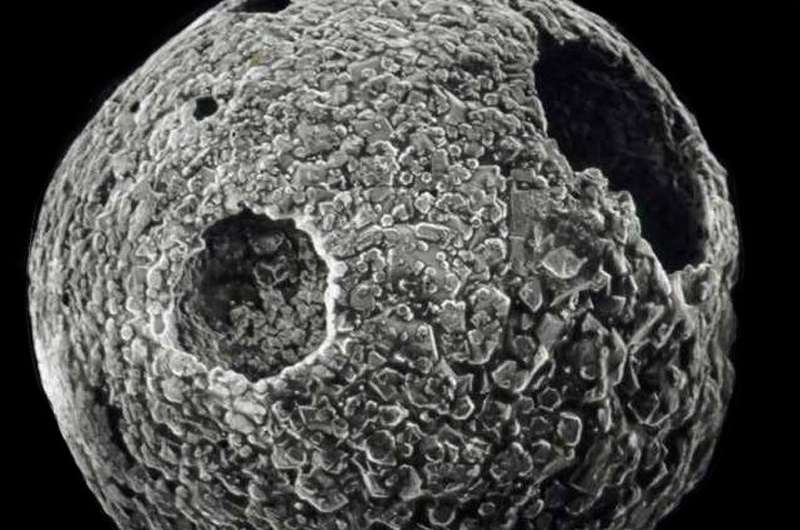Cosmic dust particles deploy bubble parachutes on their fiery descent, scientists discover

Bubbles acting like parachutes are deployed by some cosmic dust particles on their entry into Earth's atmosphere, preventing them from burning up.
This is the conclusion of a new study carried out by a researcher from Imperial College London. Cosmic dust particles originate from events such the arrival of comets in the inner solar system and collisions between asteroids, which pulverises them into dust. Some make it through the rapid descent through Earth's atmosphere, providing microscopic records of some of the earliest events in our solar system.
The researcher found that cosmic dust particles containing water-rich minerals survive atmospheric entry more easily than water-free cosmic dust. Their calculations suggest the survival of water-rich cosmic dust is approximately double that of dry dust.
The reason why some of the water-rich particles survive the descent is because they contain clay minerals or mud, which have water trapped in them. During the decent through the Earth's atmosphere, the dust turns into little droplets of molten rock, known as magma, and water inside it boils. This turns the dust into a magma foam bubble, which expands and becomes lighter and cooler, acting like a parachute.
Dr Matthew Genge, author of the paper from the Department of Earth Science and Engineering at Imperial, said: "Think of microscopic rice bubbles made of molten rock and you get the picture about what this cosmic dust looks like. The results were surprising. The sudden swelling of particles and decrease in density acts like a parachute slowing them quickly and decreasing their temperatures by 100 degrees Celsius."

As twice as many water-rich cosmic dust particles survive their decent to Earth, compared to water-free particles, it is likely that scientists have been analysing many more samples from ancient events involving water-rich asteroids, compared to events involving water-free asteroids. This may be skewing our understanding of the solar system.
In the new research, published in the journal Geophysical Research Letters, Dr Genge developed a mathematical model to understand the conditions experienced by both water-rich and water-free particles during their atmospheric entry, to see what happens when particles suddenly expand. This model was underpinned by the observations carried out by Dr Genge of cosmic dust sourced from Antarctica.
Cosmic dust particles hit the atmosphere at nearly 40,000 kilometres per hour, roughly 11 kilometres per second. They are intensely heated by collisions with molecules in the air. Many of these particles are completely destroyed by the heating process, turning into gas, which dissipates into the atmosphere.
The ones that survive the descent melt to form tiny little droplets of magma, which Dr Genge calls 'cosmic spherules' and which are the width of a human hair.
Dr Genge added: "Cosmic dust provides us with direct evidence of events that may have happened in our solar system billions of years ago. However, our study is showing us that water rich particles may be more likely to survive entry compared to dry ones. Scientists now need to take this into consideration when they are re-constructing ancient cosmic events or trying to develop a more accurate picture of the geological make-up of our solar system."
This study builds on earlier research carried out by Dr Genge. He and his team previously discovered that cosmic dust can be found in urban places such as on rooftops in major cities, and not just in isolated pristine environments such as Antarctica. The Imperial researcher also discovered that much of the cosmic dust in our solar system originates from an asteroid belt located between Jupiter and Mars.
More information: Matthew J. Genge. Vesicular parachutes increase the abundance of micrometeorites from water-rich asteroids on Earth., Geophysical Research Letters (2017). DOI: 10.1002/2016GL072490
Journal information: Geophysical Research Letters
Provided by Imperial College London





















